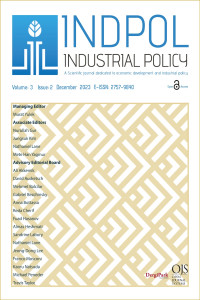Abstract
Growth theory suggests that technological development is the primary determinant of long-term economic growth, and research and development (R&D) activities are considered the driving force of technological development. This study aims to investigate the relationship between economic growth and R&D spending. To this end, we study the relationship between gross domestic product (GDP) per capita and the ratio of R&D expenditures to GDP in a group of developing and newly developed economies (namely, Brazil, Chile, Colombia, Indonesia, India, Peru, Republic of Korea, Russian Federation, Singapore, Thailand, and Türkiye) using annual data from 2000 to 2020. Using the fixed effects model, a panel data analysis is estimated, where gross domestic product (GDP) per capita is used as the dependent variable; R&D expenditures as a ratio of GDP, number of technicians in the R&D sector, and number of researchers in the R&D sector are used as independent variables. We also utilized gross fixed capital formation, labor force, and aggregate government expenditures as a ratio of GDP as control variables. The results indicate a significant and positive relation between economic growth and R&D-related explanatory variables. We also find that the model’s control variables have positive and significant effects on economic growth. Given its favorable impact on economic growth, especially developing countries may be advised to allocate more resources to R&D activities.
References
- Aghion P., & Howitt P. (1992), A Model of Growth Through Creative Destruction. Econometrica, 60(2), pp. 323-351.
- Arrow, K. J. (1962). Economic Welfare and the Allocation of Resources for Invention. In The Rate and Direction of Inventive Activity: Economic and Social Factors. Princeton University Press.
- Ayyıldız, F. V. & Demirci, O. (2022). Ar-Ge harcama gruplarının ekonomik büyüme üzerindeki etkileri: Türkiye örneğinde yapay sinir ağları ile ARDL analizi . Trends in Business and Economics , 36(4), pp. 346-358.
- Driscoll, J. C., & Kraay, A. C. (1998). Consistent covariance matrix estimation with spatially dependent panel data. Review of economics and statistics, 80(4), 549-560.
- Göze Kaya, D. (2019). Ar-Ge Harcamalarının Gelişimi: Tr-Ab Üzerine Bir Değerlendirme. Atatürk Üniversitesi İktisadi ve İdari Bilimler Dergisi , 33(3), pp. 791-812.
- Griliches, Z. (1992), The Search for R&D Spillovers. The Scandinavian Journal of Economics. 94, pp. 29-47.
- Kiselakova, D., Sofrankova, B., Cabinova, V., Onuferova, E., & Soltesova, J. (2018), The impact of R&D expenditure on the development of global competitiveness within the CEE EU countries, Journal of Competitiveness, 10(3), pp. 34–50.
- Lichtenberg, F. (1992) R&D Investment and International Productivity Differences. NBER WP, 4161.
- Lucas Jr, R. E. (1988), On the Mechanics of Economic Development. Journal of Monetary Economics, 22(1), pp. 3-42. Park, W. G. (1995). International R&D Spillovers and OECD Economic Growth. Economic Inquiry, 33(4), 571-591.
- Romer, P. M. (1986), Increasing returns and economic growth, American Economic Review, 94(5), pp. 1002-1037.
- Samimi, A. J., & Alerasoul, S. M. (2009). R&D and Economic Growth: New Evidence From Some Developing Countries. Australian Journal of Basic and Applied Sciences, 3(4), pp. 3464- 3469.
- Simionescu, M., Lazányi, K., Sopková, G., Dobeš, K., & Balcerzak, P. A. (2017), Determinants of economic growth in V4 countries and Romania, Journal of Competitiveness, 9/1: 103–116.
- Schmidheiny, K. (2013). Short Guides to Microeconometrics. Basel: Unversitat Basel
- Stock, J. H., & Watson, M. W. (2020). Introduction to Econometrics. Pearson.
- Wooldirdge, J. (2002). Econometric analysis of cross section and panel data. Massachusetts: MIT Press.
- World Bank. (2023). World Development Indicators. Retrieved from: https://databank.worldbank.org/source/world-development-indicators
Abstract
References
- Aghion P., & Howitt P. (1992), A Model of Growth Through Creative Destruction. Econometrica, 60(2), pp. 323-351.
- Arrow, K. J. (1962). Economic Welfare and the Allocation of Resources for Invention. In The Rate and Direction of Inventive Activity: Economic and Social Factors. Princeton University Press.
- Ayyıldız, F. V. & Demirci, O. (2022). Ar-Ge harcama gruplarının ekonomik büyüme üzerindeki etkileri: Türkiye örneğinde yapay sinir ağları ile ARDL analizi . Trends in Business and Economics , 36(4), pp. 346-358.
- Driscoll, J. C., & Kraay, A. C. (1998). Consistent covariance matrix estimation with spatially dependent panel data. Review of economics and statistics, 80(4), 549-560.
- Göze Kaya, D. (2019). Ar-Ge Harcamalarının Gelişimi: Tr-Ab Üzerine Bir Değerlendirme. Atatürk Üniversitesi İktisadi ve İdari Bilimler Dergisi , 33(3), pp. 791-812.
- Griliches, Z. (1992), The Search for R&D Spillovers. The Scandinavian Journal of Economics. 94, pp. 29-47.
- Kiselakova, D., Sofrankova, B., Cabinova, V., Onuferova, E., & Soltesova, J. (2018), The impact of R&D expenditure on the development of global competitiveness within the CEE EU countries, Journal of Competitiveness, 10(3), pp. 34–50.
- Lichtenberg, F. (1992) R&D Investment and International Productivity Differences. NBER WP, 4161.
- Lucas Jr, R. E. (1988), On the Mechanics of Economic Development. Journal of Monetary Economics, 22(1), pp. 3-42. Park, W. G. (1995). International R&D Spillovers and OECD Economic Growth. Economic Inquiry, 33(4), 571-591.
- Romer, P. M. (1986), Increasing returns and economic growth, American Economic Review, 94(5), pp. 1002-1037.
- Samimi, A. J., & Alerasoul, S. M. (2009). R&D and Economic Growth: New Evidence From Some Developing Countries. Australian Journal of Basic and Applied Sciences, 3(4), pp. 3464- 3469.
- Simionescu, M., Lazányi, K., Sopková, G., Dobeš, K., & Balcerzak, P. A. (2017), Determinants of economic growth in V4 countries and Romania, Journal of Competitiveness, 9/1: 103–116.
- Schmidheiny, K. (2013). Short Guides to Microeconometrics. Basel: Unversitat Basel
- Stock, J. H., & Watson, M. W. (2020). Introduction to Econometrics. Pearson.
- Wooldirdge, J. (2002). Econometric analysis of cross section and panel data. Massachusetts: MIT Press.
- World Bank. (2023). World Development Indicators. Retrieved from: https://databank.worldbank.org/source/world-development-indicators
Details
| Primary Language | English |
|---|---|
| Subjects | Macroeconomics (Other) |
| Journal Section | Research Articles |
| Authors | |
| Early Pub Date | December 30, 2023 |
| Publication Date | December 30, 2023 |
| Published in Issue | Year 2023 Volume: 3 Issue: 2 |


